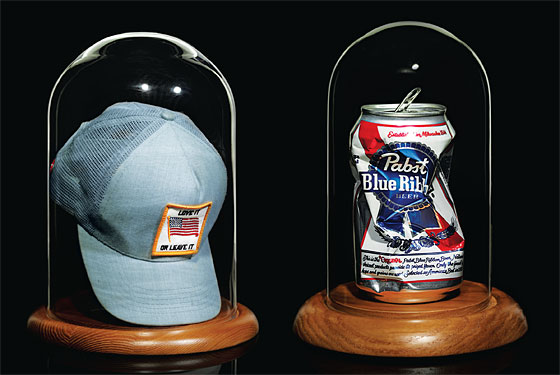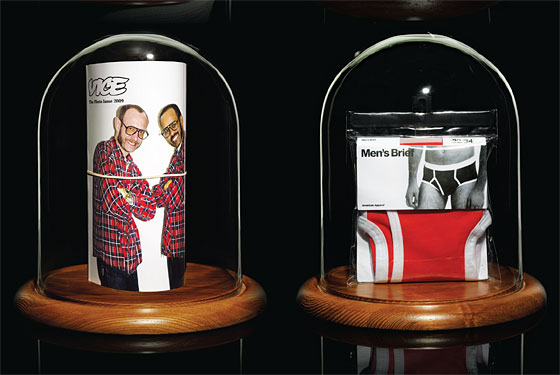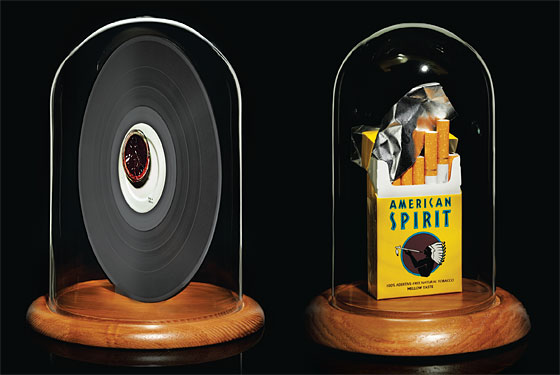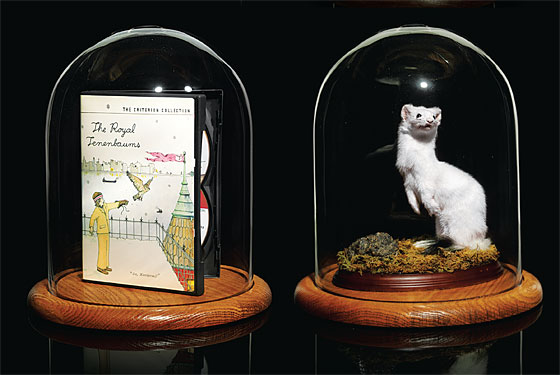
If I speak of the degeneration of our most visible recent subculture, the hipster, it’s an awkward occasion. Someone will point out that hipsters are not dead, they still breathe, they live on my block. Yet it is evident that we have reached the end of an epoch in the life of the type. Its evolution lasted from 1999 to 2009, though it has shifted appearance dramatically over the decade. It survived this year; it may persist. Indications are everywhere, however, that we have come to a moment of stocktaking.
Novelty books on the order of Stuff Hipsters Hate and Look at This Fucking Hipster began appearing again this year, reliving the hipster’s previous near death in 2003 (titles then: A Field Guide to the Urban Hipster; The Hipster Handbook). Institutions associated with the hipster label have begun fleeing it. Dov Charney, CEO of American Apparel, announced in August that “hipster is over” and “hipsters are from a certain time period.” Gawker proposed to substitute a new name for the hipster by fiat—approving, after some consideration, the term fauxhemian.
Elsewhere—and especially in Europe—the deathbed scene looks more like an apotheosis. One German paper rounded up that country’s most recent reports of hipster emergence: “The current issue of the magazine Neon sees them at a club in Moscow, the Berlin Tagesspiegel spotted them yet again this week in the bars on Oranienstraße, Taz reported that in the ‘US hipster scene’ it’s cool to dress like Indians, the Neue Zürcher Zeitung knows that in Stockholm they are drawn to the district of Södermalm, Geo Saison had drinks with them at a bar in Prague, Die Welt found them in Australia from Sydney to Brisbane, the Sunday Frankfurter Allgemeine Zeitung knows the Parisian ‘Hipster-labels,’ and the weekend edition of the Süddeutsche Zeitung commented recently that ‘big-city hipsters’ are now decorating their apartments with taxidermy.” The hipster has been reborn, too, in the American shopping mall, where Hot Topic sells thick-framed lensless eyeglasses to tweens and Nine West sells a “Hipster” sandal.
A key myth repeated about the hipster, by both the innocent and the underhanded, is that it has no definition. In August, after noting that the New York Times had printed hipster as a noun or an adjective more than 250 times in the previous year, Philip Corbett, the paper’s grammarian, wrote an open letter to the newsroom warning against its use. He certainly could have objected that it made for lazy headline copy, or that a derogatory term was being misused as praise. Instead, he objected that it wasn’t clear enough what the word means.
We do know what hipster means—or at least we should. The term has always possessed adequately lucid definitions; they just happen to be multiple. If we refuse to enunciate them, it may be because everyone affiliated with the term has a stake in keeping it murky. Hipster accusation has been, for a decade, the outflanking maneuver par excellence for competitors within a common field of cool. “Two Hipsters Angrily Call Each Other ‘Hipster,’ ” a headline in The Onion put it most succinctly.
The longer we go without an attempt to explain the term simply and clearly, the longer we are at the mercy of its underlying magic. In the interest of disenchantment, let me trace a history and offer some definitions. If we see the hipsters plain, maybe we’ll also see where they might come undone.
When we talk about the contemporary hipster, we’re talking about a subcultural figure who emerged by 1999, enjoyed a narrow but robust first phase until 2003, and then seemed about to dissipate into the primordial subcultural soup, only to undergo a reorganization and creeping spread from 2004 to the present.
The matrix from which the hipster emerged included the dimension of nineties youth culture, often called alternative or indie, that defined itself by its rejection of consumerism. Yet in an ethnography of Wicker Park, Chicago, in the nineties, the sociologist Richard Lloyd documented how what he called “neo-bohemia” unwittingly turned into something else: the seedbed for post-1999 hipsterism. Lloyd showed how a culture of aspiring artists who worked day jobs in bars and coffee shops could unintentionally provide a milieu for new, late-capitalist commerce in design, marketing, and web development. The neo-bohemian neighborhoods, near to the explosion of new wealth in city financial centers, became amusement districts for a new class of rich young people. The indie bohemians (denigrated as slackers) encountered the flannel-clad proto-businessmen and dot-com paper millionaires (denigrated as yuppies), and something unanticipated came of this friction.
The Lower East Side and Williamsburg in New York, Capitol Hill in Seattle, Silver Lake in L.A., the Inner Mission in San Francisco: This is where the contemporary hipster first flourished. Over the years, there developed such a thing as a hipster style and range of art and finally, by extension, something like a characteristic attitude and Weltanschauung. Fundamentally, however, the hipster continues to be defined by the same tension faced by those early colonizers of Wicker Park. The hipster is that person, overlapping with the intentional dropout or the unintentionally declassed individual—the neo-bohemian, the vegan or bicyclist or skatepunk, the would-be blue-collar or postracial twentysomething, the starving artist or graduate student—who in fact aligns himself both with rebel subculture and with the dominant class, and thus opens up a poisonous conduit between the two.

The question arises: What was it about the turn-of-the-century moment that made it so clear—as it was immediately clear—that the character had to have this name, the hipster, which was so fraught with historical meaning? Subculture has never had a problem with neologism or exploitation of slang, from emo to punk to hippie. The hipster, however, was someone else already. Specifically, he was a black subcultural figure of the late forties, best anatomized by Anatole Broyard in an essay for the Partisan Review called “A Portrait of the Hipster.” A decade later, the hipster had evolved into a white subcultural figure. This hipster—and the reference here is to Norman Mailer’s “The White Negro” essay for Dissent in 1957—was explicitly defined by the desire of a white avant-garde to disaffiliate itself from whiteness, with its stain of Eisenhower, the bomb, and the corporation, and achieve the “cool” knowledge and exoticized energy, lust, and violence of black Americans. (Hippie itself was originally an insulting diminutive of hipster, a jab at the sloppy kids who hung around North Beach or Greenwich Village after 1960 and didn’t care about jazz or poetry, only drugs and fun.)
The hipster, in both black and white incarnations, in his essence had been about superior knowledge—what Broyard called “a priorism.” He insisted that hipsterism was developed from a sense that minorities in America were subject to decisions made about their lives by conspiracies of power they could never possibly know. The hip reaction was to insist, purely symbolically, on forms of knowledge that they possessed before anyone else, indeed before the creation of positive knowledge—a priori. Broyard focused on the password language of hip slang.
The return of the term after 1999 reframed the knowledge question. Hipster, in its revival, referred to an air of knowing about exclusive things before anyone else. The new young strangers acted, as people said then, “hipper than thou.” At first their look may also have overlapped enough with a short-lived moment of neo-Beat and fifties nostalgia (goatees, fedoras, Swingers-style duds) to help call up the term. But these hipsters were white, and singularly unmoved by race and racial integration.
Indeed, the White Hipster—the style that suddenly emerged in 1999—inverted Broyard’s model to particularly unpleasant effect. Let me recall a string of keywords: trucker hats; undershirts called “wifebeaters,” worn alone; the aesthetic of basement rec-room pornography, flash-lit Polaroids, and fake-wood paneling; Pabst Blue Ribbon; “porno” or “pedophile” mustaches; aviator glasses; Americana T-shirts from church socials and pig roasts; tube socks; the late albums of Johnny Cash; tattoos.
Key institutions were the fashion magazine Vice, which moved to New York from Montreal in 1999 and drew on casual racism and porn to refresh traditional women’s-magazine features (“It Happened,” “Dos and Don’ts”) and overcome the stigma of boys looking at photos of clothes; Alife, the hipster-branding consultancy–cum–sneaker store, also launched in 1999, staffed by employees who claimed a rebel background in punk/skateboarding/graffiti to justify why they were now in retail sportswear; and American Apparel, which launched in L.A. in 1997 as an anti-sweatshop T-shirt manufacturer and gradually changed its advertising focus from progressive labor practices to amateur soft-core porn.
These were the most visible emblems of a small and surprising subculture, where the source of a priori knowledge seemed to be nostalgia for suburban whiteness. As the White Negro had once fetishized blackness, the White Hipster fetishized the violence, instinctiveness, and rebelliousness of lower-middle-class “white trash.” “I love being white, and I think it’s something to be proud of,” Vice founder Gavin McInnes told the Times in 2003.
This recalled the seventies culture of white flight to the suburbs, and the most uncanny thing about the turn-of-the-millennium white hipsters is that symbolically, in their styles and attitudes, they seemed to announce that whiteness and capital were flowing back into the formerly impoverished city. They wore what they were in economic and structural terms—because for reasons mysterious to the participants, those things suddenly seemed “cool” for an urban setting.
The early White Hipster aped the “unmeltable ethnics” (Irish, Italian, Polish, and so forth), but now with the ethnicities scrubbed off. And rather than an indie or bohemian subculture, it felt like an ethnicity—with its clannishness, its claiming of microneighborhoods from other, older migrants (Chinese, Puerto Ricans, Orthodox Jews), and its total uninterest in integrating into the local populations.
It would be too limited, however, to understand the contemporary hipster as simply someone concerned with a priori knowledge as a means of social dominance. In larger manifestations, in private as well as on the street, contemporary hipsterism has been defined by an obsessive interest in the conflict between knowingness and naïveté, guilty self-awareness and absolved self-absorption. Consider hipster art. At the same time that hipsters were dressing like seventies-model Stanley Kowalskis, they were consuming culture that was considerably more anxious about machismo, heterosexuality, and maturity.

The most exemplary hipster artists are probably the early Dave Eggers, of A Heartbreaking Work of Staggering Genius (2000) and his journal McSweeney’s (1998), and Wes Anderson, director of Rushmore (1998) and The Royal Tenenbaums (2001). These and other artists who were referred to as hipster produced a body of work that was otherwise classed more precisely as “precious” or “twee.” The older Scottish band Belle & Sebastian, not a part of this system at their own genesis, stood at the head of a new soft-spoken, often anti-homophobic aesthetic in music. (Eggers tried to claim the older Flaming Lips as allies. Bright Eyes, Sufjan Stevens, and Joanna Newsom were later manifestations.)
The tensions of this art revolved around the very old dyad of adulthood and a child-centered world, but landed heavily on the side of the child. Formally, there was an aestheticization of the mode of pastiche, which Fredric Jameson identified in the early eighties as a characteristic mode of postmodern narrative. Here, however, “blank parody” gave way to a reconstruction of past techniques more perfect than the originals, in an irony without sarcasm, bitterness, or critique. Reflexivity was used as a means to get back to sentimental emotion.
In the nineties, it had become commonplace to assume that one could no longer say heartfelt, sincere things outright, because all genuine utterance would be stolen and repeated as advertising. Whatever anguish this caused seemed gone in the artifacts of the early aughts. The ironic games were weightless. The emotional expressions suggested therapy culture, but hipster art often kitschified—or at least made playful—the weightiest tragedies, whether personal or historical: orphans and cancer for Eggers, the Holocaust and 9/11 for Jonathan Safran Foer.
The hipster moment did not produce artists, but tattoo artists. It did not yield a great literature, but it made good use of fonts.
By 2003, though, an overwhelming feeling of an end to hipsterism permeated the subculture. It seems possible that the White Hipster was born in part as a reaction to the 1999 WTO protests in Seattle—the emboldened anti-capitalism that was the signal youth rebellion of the century’s end. But 2003 spelled the beginning of the Iraq invasion, and a pivot in the national mood from post-9/11 mourning to patriotic aggression and violence. The wifebeater-wearer’s machismo no longer felt subversive, and while the more sinister strain of White Hipster style started to diminish, the artistic concern with innocence turned from human absolution to the fragile world of furry creatures, trees, and TRS-80s.
Suddenly, the hipster transformed. Most succinctly—though this is too simple—it began to seem that a “green” hipster had succeeded the white. Certainly the points of reference shifted from midwestern suburbs to animals, wilderness, plus the occasional Native American. Best perhaps to call this the Hipster Primitive, for linked to the Edenic nature-as-playground motif was a fascination with early-eighties computer electronics and other rudimentary or superannuated technologies.
In culture, the Hipster Primitive moment recovered the sound and symbols of pastoral innocence with an irony so fused into the artworks it was no longer visible. Music led the artistry of this phase, and the period’s flagship publication, the record-review website and tastemaker Pitchfork, picked up as Vice declined. Here are the names of some significant bands, post-2004: Grizzly Bear, Neon Indian, Deerhunter, Fleet Foxes, Department of Eagles, Wolf Parade, Band of Horses, and, most centrally, Animal Collective. (On the electronic-primitive side, LCD Soundsystem.) Listeners heard animal sounds and lovely Beach Boys–style harmonies; lyrics and videos pointed to rural redoubts, on wild beaches and in forests; life transpired in some more loving, spacious, and manageable future, possibly of a Day-Glo or hallucinatory brightness. It was not unheard of to find band members wearing masks or plush animal suits.
Where the White Hipster was relentlessly male, crowding out women from public view (except as Polaroid muses or SuicideGirls), the Hipster Primitive feminized hipster markers; one spoke now of headdresses and Sally Jessy Raphael glasses, not just male facial hair. Women took up cowboy boots, then dark-green rubber Wellingtons, like country squiresses off to visit the stables. Men gave up the porno mustache for the hermit or lumberjack beard. Flannel returned, as did hunting jackets in red-and-black check. Scarves proliferated unnecessarily, conjuring a cold woodland night (if wool) or a desert encampment (if a kaffiyeh). Then scarves were worn as bandannas, as when Mary-Kate Olsen sported one, like a cannibal Pocahontas, hungry enough to eat your arm.
There were also some practical technological withdrawals. As CDs declined, LP records gained sales for the first time in two decades—seemingly purchased by the same kids who had 3,000 songs on their laptops. The most advanced hipster youth even deprived their bikes of gears. The fixed-gear bike now ranks as the second-most-visible urban marker of hip, and not the least of its satisfactions is its simple mechanism.

Above all, the post-2004 hipster could be identified by one stylistic marker that transcended fashion to be something as fundamental as a cultural password: jeans that were tight to the calves and ankles. As much as I’ve investigated this, I can’t say I understand the origin of the skinny jean. Why, of many candidates for fashion statements, did it become ubiquitous? All that seems obvious is that it was an opportunity to repudiate the White Hipster moment, while still retaining the furthest possible distinction from the mainstream. The skinny jean was instant and utter inversion, attaining the opposite extreme from the boot-cut flared motorcycle jeans of the White Hipster. It proved the vitality of a hipster community. It meant that the group impulse would hold, no matter how vertiginous the changes.
Through both phases of the contemporary hipster, and no matter where he identifies himself on the knowingness spectrum, there exists a common element essential to his identity, and that is his relationship to consumption. The hipster, in this framework, is continuous with a cultural type identified in the nineties by the social critic Thomas Frank, who traced it back to Madison Avenue’s absorption of a countercultural ethos in the late sixties. This type he called the “rebel consumer.”
The rebel consumer is the person who, adopting the rhetoric but not the politics of the counterculture, convinces himself that buying the right mass products individualizes him as transgressive. Purchasing the products of authority is thus reimagined as a defiance of authority. Usually this requires a fantasized censor who doesn’t want you to have cologne, or booze, or cars. But the censor doesn’t exist, of course, and hipster culture is not a counterculture. On the contrary, the neighborhood organization of hipsters—their tight-knit colonies of similar-looking, slouching people—represents not hostility to authority (as among punks or hippies) but a superior community of status where the game of knowing-in-advance can be played with maximum refinement. The hipster is a savant at picking up the tiny changes of rapidly cycling consumer distinction.
This in-group competition, more than anything else, is why the term hipster is primarily a pejorative—an insult that belongs to the family of poseur, faker, phony, scenester, and hanger-on. The challenge does not clarify whether the challenger rejects values in common with the hipster—of style, savoir vivre, cool, etc. It just asserts that its target adopts them with the wrong motives. He does not earn them.
It has long been noticed that the majority of people who frequent any traditional bohemia are hangers-on. Somewhere, at the center, will be a very small number of hardworking writers, artists, or politicos, from whom the hangers-on draw their feelings of authenticity. Hipsterdom at its darkest, however, is something like bohemia without the revolutionary core. Among hipsters, the skills of hanging-on—trend-spotting, cool-hunting, plus handicraft skills—become the heroic practice. The most active participants sell something—customized brand-name jeans, airbrushed skateboards, the most special whiskey, the most retro sunglasses—and the more passive just buy it.
Of course, there are artists of hipster-related sensibility who remain artists. In the neighborhoods, though, there was a feeling throughout the last decade that the traditional arts were of little interest to hipsters because their consumer culture substituted a range of narcissistic handicrafts similar enough to sterilize the originals. One could say, exaggerating only slightly, that the hipster moment did not produce artists, but tattoo artists, who gained an entire generation’s arms, sternums, napes, ankles, and lower backs as their canvas. It did not produce photographers, but snapshot and party photographers: Last Night’s Party, Terry Richardson, the Cobra Snake. It did not produce painters, but graphic designers. It did not yield a great literature, but it made good use of fonts. And hipsterism did not make an avant-garde; it made communities of early adopters.
The most confounding element of the hipster is that, because of the geography of the gentrified city and the demography of youth, this “rebel consumer” hipster culture shares space and frequently steals motifs from truly anti-authoritarian youth countercultures. Thus, baby-boomers and preteens tend to look at everyone between them and say: Isn’t this hipsterism just youth culture? To which folks age 19 to 29 protest, No, these people are worse. But there is something in this confusion that suggests a window into the hipster’s possible mortality.
True countercultures may wax and wane in numbers, but a level of youth hostility to the American official compromise has been continuous since World War II. Over the past decade, hipsters have mixed with particular elements of anarchist, free, vegan, environmentalist, punk, and even anti-capitalist communities. One glimpses behind them the bike messengers, straight-edge skaters, Lesbian Avengers, freegans, enviro-anarchists, and interracial hip-hoppers who live as they please, with a spiritual middle finger always raised.
And hipster motifs and styles, when you dig into them, are often directly taken from these adjacent countercultures. The fixed-gear bike came from bike messengers and the anarchist culture of groups like Critical Mass and Bikes Not Bombs. Hipster approval of locavore food (because local cheeses and grass-fed beef are expensive, rare, and knowledge-intensive) brings elitism to the left-environmentalist campaign for deindustrialized agriculture. Even those trucker hats were familiar to those of us who first saw them on the wrong heads in 1999; they’d been worn in punk rock in the late eighties and early nineties, through the Reagan-Bush recession, as an emblem of the “age of diminished expectations.”
Can the hipster, by virtue of proximity if nothing else, be woken up? One can’t expect political efflorescence from an anti-political group. Yet the mainstreaming of hipsterism to the suburbs and the mall portends hipster self-disgust. (Why bother with a lifestyle that everyone now knows?) More important, it guarantees the pollination of a vast audience with seeds stolen from the counterculture. Granted, they have been husked of significance—but couldn’t a 12-year-old with deep Google skills figure out what they originally meant? And might they still germinate?
Something was already occurring in the revivification that transpired in 2003. The White Hipster was truly grotesque, whereas within the Hipster Primitive there emerged a glimmer of an idea of refusal. In the U.K., American-patterned hipsters in Hackney and Shoreditch are said to be turning more toward an ethos of androgyny, drag, the queer. In recent hipster art, Animal Collective’s best-known lyric is this: “I don’t mean to seem like I / Care about material things, like our social stats / I just want four walls and / Adobe slats for my girls.” The band members masked their faces to avoid showing themselves to the culture of idolators. If a hundred thousand Americans discovered that they, too, hated the compromised culture, they might not look entirely unlike the Hipster Primitive. Just no longer hip.
Adapted from What Was the Hipster? A Sociological Investigation, by the editors of n+1, published this month.